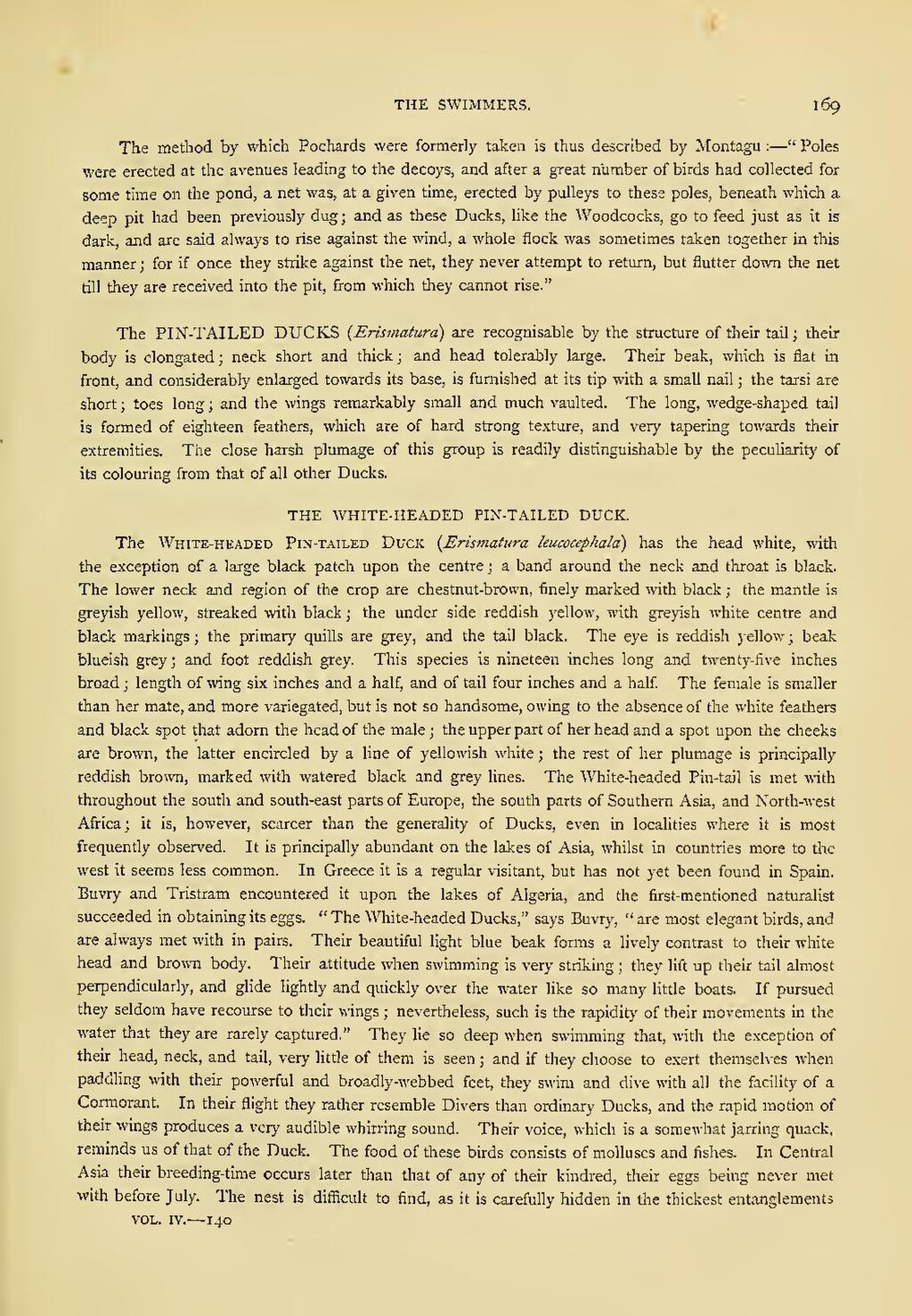The method by which Pochards were formerly taken is thus described by Montagu:—"Poles were erected at the avenues leading to the decoys, and after a great number of birds had collected for some time on the pond, a net was, at a given time, erected by pulleys to these poles, beneath which a deep pit had been previously dug; and as these Ducks, like the Woodcocks, go to feed just as it is dark, and are said always to rise against the wind, a whole flock was sometimes taken together in this manner; for if once they strike against the net, they never attempt to return, but flutter down the net till they are received into the pit, from which they cannot rise."
The PIN-TAILED DUCKS (Erismatura) are recognisable by the structure of their tail; their body is elongated; neck short and thick; and head tolerably large. Their beak, which is flat in front, and considerably enlarged towards its base, is furnished at its tip with a small nail; the tarsi are short; toes long; and the wings remarkably small and much vaulted. The long, wedge-shaped tail is formed of eighteen feathers, which are of hard strong texture, and very tapering towards their extremities. The close harsh plumage of this group is readily distinguishable by the peculiarity of its colouring from that of all other Ducks.
THE WHITE-HEADED PIN-TAILED DUCK.
The White-headed Pin-tailed Duck (Erismatura leucocephala) has the head white, with the exception of a large black patch upon the centre; a band around the neck and throat is black. The lower neck and region of the crop are chestnut-brown, finely marked with black; the mantle is greyish yellow, streaked with black; the under side reddish yellow, with greyish white centre and black markings; the primary quills are grey, and the tail black. The eye is reddish yellow; beak blueish grey; and foot reddish grey. This species is nineteen inches long and twenty-five inches broad; length of wing six inches and a half, and of tail four inches and a half. The female is smaller than her mate, and more variegated, but is not so handsome, owing to the absence of the white feathers and black spot that adorn the head of the male; the upper part of her head and a spot upon the cheeks are brown, the latter encircled by a line of yellowish white; the rest of her plumage is principally reddish brown, marked with watered black and grey lines. The White-headed Pin-tail is met with throughout the south and south-east parts of Europe, the south parts of Southern Asia, and North-west Africa; it is, however, scarcer than the generality of Ducks, even in localities where it is most frequently observed. It is principally abundant on the lakes of Asia, whilst in countries more to the west it seems less common. In Greece it is a regular visitant, but has not yet been found in Spain. Buvry and Tristram encountered it upon the lakes of Algeria, and the first-mentioned naturalist succeeded in obtaining its eggs. "The White-headed Ducks," says Buvry, "are most elegant birds, and are always met with in pairs. Their beautiful light blue beak forms a lively contrast to their white head and brown body. Their attitude when swimming is very striking; they lift up their tail almost perpendicularly, and glide lightly and quickly over the water like so many little boats. If pursued they seldom have recourse to their wings; nevertheless, such is the rapidity of their movements in the water that they are rarely captured." They lie so deep when swimming that, with the exception of their head, neck, and tail, very little of them is seen; and if they choose to exert themselves when paddling with their powerful and broadly-webbed feet, they swim and dive with all the facility of a Cormorant. In their flight they rather resemble Divers than ordinary Ducks, and the rapid motion of their wings produces a very audible whirring sound. Their voice, which is a somewhat jarring quack, reminds us of that of the Duck. The food of these birds consists of molluscs and fishes. In Central Asia their breeding-time occurs later than that of any of their kindred, their eggs being never met with before July. The nest is difficult to find, as it is carefully hidden in the thickest entanglements
